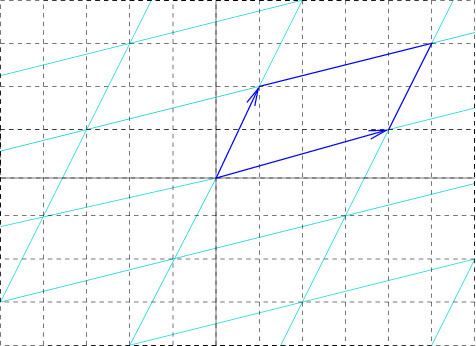 | ||
In geometry, crystallography, mineralogy, and solid state physics, a primitive cell is a minimum volume cell (a unit cell) corresponding to a single lattice point of a structure with discrete translational symmetry. The concept is used particularly in describing crystal structure in two and three dimensions, though it makes sense in all dimensions. A lattice can be characterized by the geometry of its primitive cell.
Contents
The primitive cell is a primitive unit. A primitive unit is a section of the tiling (usually a parallelogram or a set of neighboring tiles) that generates the whole tiling using only translations, and is as small as possible.
The primitive cell is a fundamental domain with respect to translational symmetry only. In the case of additional symmetries a fundamental domain is smaller.
The primitive translation vectors a→1, a→2, a→3 span a lattice cell of smallest volume for a particular three-dimensional lattice, and are used to define a crystal translation vector
where u1, u2, u3 are integers, translation by which leaves the lattice invariant. That is, for a point in the lattice r, the arrangement of points appears the same from r′ = r + T→ as from r.
Since the primitive cell is defined by the primitive axes (vectors) a→1, a→2, a→3, the volume Vp of the primitive cell is given by the parallelepiped from the above axes as
A primitive cell is considered to contain exactly one lattice point. For unit cells generally, lattice points that are shared by n cells are counted as 1/n of the lattice points contained in each of those cells; so for example a primitive unit cell in three dimensions which has lattice points only at its eight vertices is considered to contain 1/8 of each of them.
A Wigner–Seitz cell is a primitive cell centered on the single lattice point it contains. This is a type of Voronoi cell. The Wigner–Seitz cell of the reciprocal lattice in momentum space is called the Brillouin zone.
2-dimensional primitive cell
A 2-dimensional primitive cell is a parallelogram, which in special cases may have orthogonal angles, or equal lengths, or both.
3-dimensional primitive cell
A crystal can be categorized by its lattice and the atoms that lie in a primitive cell (the basis). A cell will fill all the lattice space without leaving gaps by repetition of crystal translation operations.
A 3-dimensional primitive cell is a parallelepiped, which in special cases may have orthogonal angles, or equal lengths, or both.
